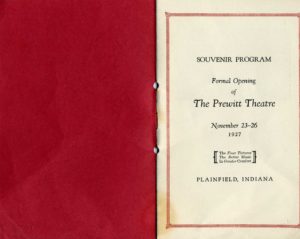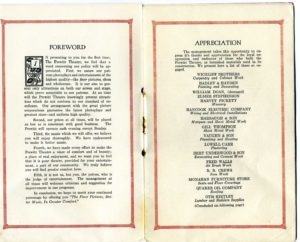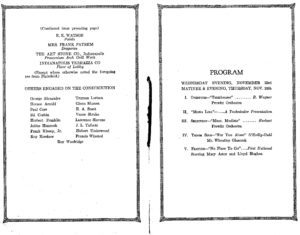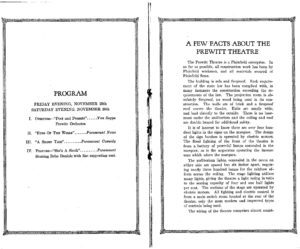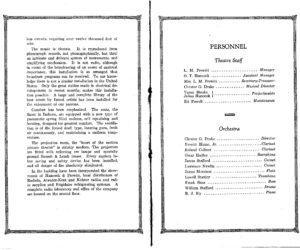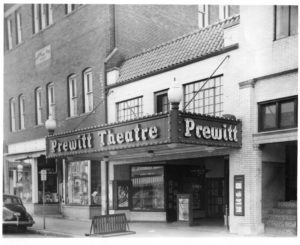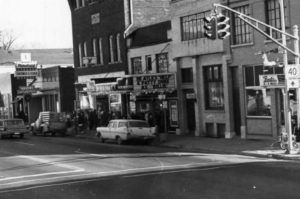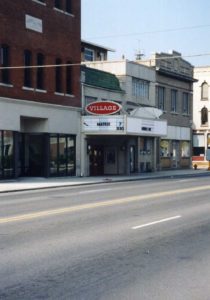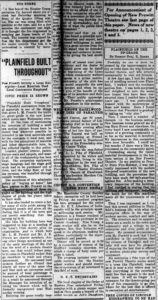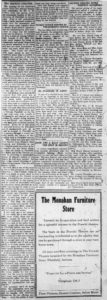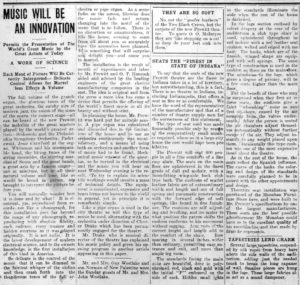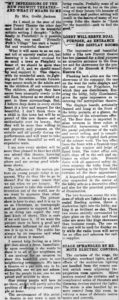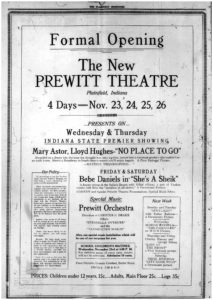Until 2021, when it was opened as The Prewitt Restaurant and Lounge, the structure at 121 West Main Street consisted of two distinct buildings. Like several others on Main Street, it functioned separately for most of its life. This overview first explores 119 West Main Street, the original Prewitt Theatre, followed by the diverse history of 121 West Main Street, formerly the First National Bank.
Owned by Mr. L. M. Prewitt, the theater was located at 119 West Main Street and offered folks a place to watch motion pictures, eat popcorn and have fun with friends. The Prewitt Theatre building was also locally known as the Village Theater. Prior to the theater, the building housed Prewitt’s Motor Sales where owner Joseph Prewitt also sold Goodrich tires. The service station was in a prime location on the National Road to provide assistance to travelers.
The Prewitt Theatre formally opened on November 23, 1927 with the feature film “No Place to Go” starring Mary Astor and Lloyd Hughes. The first “talkie” shown was Voice of the City in April 2929. Acoustic panels were soon added to the interior to accommodate the new technology.
The theater was renamed Village Theater in 1971.
119 West Main Street: The Prewitt Theatre
Origins and Construction
Few historic buildings in Plainfield have their beginnings as clearly documented as the Prewitt Theatre. On October 2, 1914, the Friday Caller reported:
“J.E. Prewitt is erecting a garage on his lot between the post office and the First National Bank… [it] will consume the entire space between the two buildings.”
The paper humorously noted that while Prewitt claimed that neighboring buildings slightly encroached on his property, he “did not intend to have those buildings moved.”
In 1906, Joseph Prewitt was the first person in Plainfield to own a car, sparking widespread curiosity. His son Lowell learned to drive at a young age. They opened the garage at 119 West Main in spring 1915, selling Ford automobiles and offering repair services along the National Road.
In 1918, the garage expanded to 211 West Main Street. Lowell later sold that property, lived in California and worked in Havana, Cuba, before returning to reclaim his original business in 1925.
Transition to Theater
In February 1927, the Plainfield Messenger hinted at plans for a modern movie theater. Two weeks later, it officially announced: “L.M. Prewitt to Build Movie.” Prewitt purchased the ZaZa Theater (101 East Main) and ran it temporarily while the new Prewitt Theatre was under construction. Once the Prewitt opened, the ZaZa closed.
- The new theater boasted:
- A white enameled brick façade
- A green Spanish tile roof
- A Moorish vaulted ceiling in the tiled lobby
- Hardwood floors designed to reduce echo
Opening on November 23–26, 1927, the project featured local labor and materials. Contributors included Hancook Electric Company, Monahan Furniture, E.E. Watson, and Otis Kirtley’s lumber company.
Business Expansion
The Prewitt quickly became a community hub:
- 1928: Lowell and Janet Prewitt opened the Sweet Shoppe
- 1929: C.L. Jessup launched a retail store in the lobby
- 1929: Janet opened the Frock Shoppe, selling dresses for $9.95 or $14.95
By 1931, they added a third story and moved into a two-floor apartment above the theater.
Continuous Improvements
The local press frequently celebrated upgrades:
- 1928: New ventilation system and an electric clock mounted above the box office
- 1929: Soundproofing and new screen
- 1931–34: Repainted marquee, red marquee lights, and white paint with green trim
The Prewitt kept pace with industry innovation:
- 1929: First all-talkie film in Hendricks County (Voice of the City)
- 1930: Leo the MGM lion made a promotional appearance
- 1931: Ticket prices reduced to 10¢ and 25¢
- Hosted free Christmas movies for schoolchildren from nearby towns
Tragedy and Tenacity
Lowell Prewitt died in 1934 at age 40. Janet continued managing the theater:
- 1938: Installed air-conditioning
- 1942 & 1948: Recovered seats
- 1944: New projectors (although a reel was misplaced during installation!)
The Golden Age & Social Change
The 1940s brought success and change:
- 1940: Gone with the Wind drew packed crowds
- 1944: Lassie Come Home became a town favorite
- 1950: Johnny Holiday, filmed at the Indiana Boys School, was a local sensation
However, the theater was originally segregated, with Black patrons excluded. Local accounts suggest Cassie Swarn persuaded Janet Prewitt to open the theater to all during World War II, pointing out that Black soldiers fighting in the war deserved equal rights at home.
Postwar Decline and Ownership Changes
In 1949, ailing Janet leased the theater to Guy and Beatrice Hancock. Guy passed away in 1952, and Beatrice continued running it. She purchased the building in 1959, the year Janet died.
- 1967: Renamed Cinema West by Clyde Nihiser
- 1970: Brief run of adult arthouse films
- 1972: Renamed again to Village Theater, and later Village West Theater
- Operated into the 1980s before the Tudor Amusement Corporation declared bankruptcy in 1988
Decline and Attempted Revival
Ownership passed through several hands:
- Banc One
- Plainfield Chamber of Commerce
- Michael Freeman
- CLF Properties LLC
In 2002, Frank Katris bought the theater, hoping to revive it with family-friendly films. Renovation started but stalled due to competition from the Metropolis Mall’s new cinema.
In 2018, the Plainfield Redevelopment Commission acquired the property. They restored the historic marquee and cleared the basement tanks.
121 West Main Street: From Bank to Boutique
Built in 1903, the structure at 121 West Main Street served as Plainfield’s second bank (after Citizens State Bank). It featured:
- Tennessee marble baseboards
- Oak counters with chipped plate glass
- A fireproof vault with three Yale timers
A 1924 robbery tested that security:
Three armed robbers stole $4,000
- Locked several employees and customers in the vault
- Escaped in a stolen Studebaker
- Identified later with help from a witness’s plate number and suspect ID
New Uses: Mortuary, Fashion, and More
- 1930: Joseph Prewitt bought the building and added a second story apartment
- 1930: Leon A. Hall opened Hall Mortuary, utilizing the old vault
- 1931: A neon sign advertised the funeral home
- James Baldock opened a beauty shop upstairs
When Hall relocated in 1937, Lyon & Lyon, a women’s apparel store, moved in. Run later by Erna McClanathan, it operated until 1959.
Ownership Tied to the Theater
From 1930 onward, ownership of 121 West Main was linked to the Prewitt Theatre. It passed from:
- Prewitt heirs → Beatrice Hancock (1961)
- Clyde and Betty Jean Nihiser (1972)
- Banc One (1988)
- Plainfield Chamber of Commerce (1994)
- Michael Freeman and Frank Katris
Modern Era: Shops and Services
In the 2000s, new tenants moved in:
- 2007: Prom to Perfect resale shop and Perfect Parties Too
- 2008–2014: Sterling Healthcare Management
- 2014: Attorney Lisa Chapman Rochelle
In 2018, the Town of Plainfield acquired the property along with the theater. In 2021, both were sold to the Keller Huff Restaurant Group.
The Prewitt Restaurant and Lounge (2021–Present)
Patrick Keller and Doug Huff merged and renovated both buildings into a premier restaurant, bar, and event space.
From:
- Theater to dining room
- Bank to funeral home to boutique to lounge
…this space has hosted a remarkable variety of businesses across more than a century of Plainfield history.



